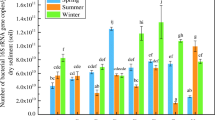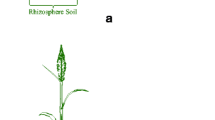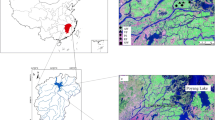Abstract
Stormwater wetlands collect and attenuate runoff-related herbicides, limiting their transport into aquatic ecosystems. Knowledge on wetland bacterial communities with respect to herbicide dissipation is scarce. Previous studies showed that hydrological and hydrochemical conditions, including pesticide removal capacity, may change from spring to summer in stormwater wetlands. We hypothesized that these changes alter bacterial communities, which, in turn, influence pesticide degradation capacities in stormwater wetland. Here, we report on bacterial community changes in a stormwater wetland exposed to pesticide runoff, and the occurrence of trz, atz, puh, and phn genes potentially involved in the biodegradation of simazine, diuron, and glyphosate. Based on T-RFLP analysis of amplified 16S rRNA genes, a response of bacterial communities to pesticide exposure was not detected. Changes in stormwater wetland bacterial community mainly followed seasonal variations in the wetland. Hydrological and hydrochemical fluctuations and vegetation development in the wetland presumably contributed to prevent detection of effects of pesticide exposure on overall bacterial community. End point PCR assays for trz, atz, phn, and puh genes associated with herbicide degradation were positive for several environmental samples, which suggest that microbial degradation contributes to pesticide dissipation. However, a correlation of corresponding genes with herbicide concentrations could not be detected. Overall, this study represents a first step to identify changes in bacterial community associated with the presence of pesticides and their degradation in stormwater wetland.



Similar content being viewed by others
References
Adrados, B., Sánchez, O., Arias, C. A., Becares, E., Garrido, L., Mas, J., Brix, H., & Morató, J. (2014). Microbial communities from different types of natural wastewater treatment systems: vertical and horizontal flow constructed wetlands and biofilters. Water Research, 55(May), 304–312.
Becker, R. M., Chambers, J. M., & Wilks, A. R. (1988). The new S language data analysis: a programming environment for data analysis and graphics. The Wadsworth & Brooks / Cole Statistics / Probability Series. Pacific Grove: Wadsworth & Brooks / Cole.
Blanck, H., Wängberg, S.-Å., & Molander, S. (1988). Pollution-induced community tolerance—a new ecotoxicological tool. In J. Cairns & J. Pratt (Eds.), 219-219–12 Functional testing of aquatic biota for estimating hazards of chemicals. West Conshohocken: ASTM International.
Budd, R., O’Geen, A., Goh, K. S., Bondarenko, S., & Gan, J. (2011). Removal mechanisms and fate of insecticides in constructed wetlands. Chemosphere, 83(11), 1581–1587.
Devers, M., Soulas, G., & Martin-Laurent, F. (2004). Real-time reverse transcription PCR analysis of expression of atrazine catabolism genes in two bacterial strains isolated from soil. Journal of Microbiological Methods, 56(1), 3–15.
Edwards, U., Rogall, T., Blöcker, H., Emde, M., & Böttger, E. C. (1989). Isolation and direct complete nucleotide determination of entire genes. Characterization of a gene coding for 16S ribosomal RNA. Nucleic Acids Research, 17(19), 7843–7853.
Gregoire, C., Elsaesser, D., Huguenot, D., Lange, J., Lebeau, T., Merli, A., Mose, R., et al. (2009). Mitigation of agricultural nonpoint-source pesticide pollution in artificial wetland ecosystems. Environmental Chemistry Letters, 7(3), 205–231.
Gregoire, C., Payraudeau, S., & Domange, N. (2010). Use and fate of 17 pesticides applied on a vineyard catchment. International Journal of Environmental Analytical Chemistry, 90(3–6), 406–420.
Imfeld, G., & Vuilleumier, S. (2012). Measuring the effects of pesticides on bacterial communities in soil: a critical review. European Journal of Soil Biology, 49(March), 22–30.
Imfeld, G., Braeckevelt, M., Kuschk, P., & Richnow, H. H. (2009). Monitoring and assessing processes of organic chemicals removal in constructed wetlands. Chemosphere, 74(3), 349–362.
Imfeld, G., Lefrancq, M., Maillard, E., & Payraudeau, S. (2013). Transport and attenuation of dissolved glyphosate and AMPA in a stormwater wetland. Chemosphere, 90(4), 1333–1339.
Keefe, S. H., Daniels, J. S. T., Runkel, R. L., Wass, R. D., Stiles, E. A., & Barber, L. B. (2010). Influence of hummocks and emergent vegetation on hydraulic performance in a surface flow wastewater treatment wetland. Water Resources Research, 46(11), 11518.
Khurana, J. L., Jackson, C. J., Scott, C., Pandey, G., Horne, I., Russell, R. J., Herlt, A., Easton, C. J., & Oakeshott, J. G. (2009). Characterization of the phenylurea hydrolases a and B: founding members of a novel amidohydrolase subgroup. Biochemical Journal, 418(2), 431–441.
Maillard, E., & Imfeld, G. (2014). Pesticide mass budget in a stormwater wetland. Environmental Science & Technology, 48(15), 8603–8611.
Maillard, E., Payraudeau, S., Faivre, E., Grégoire, C., Gangloff, S., & Imfeld, G. (2011). Removal of pesticide mixtures in a stormwater wetland collecting runoff from a vineyard catchment. Science of the Total Environment, 409(11), 2317–2324.
Meng, P., Pei, H., Hu, W., Shao, Y., & Li, Z. (2014). How to increase microbial degradation in constructed wetlands: influencing factors and improvement measures. Bioresource Technology, 157(April), 316–326.
Monard, C., Martin-Laurent, F., Devers-Lamrani, M., Lima, O., Vandenkoornhuyse, P., & Binet, F. (2010). Atz gene expressions during atrazine degradation in the soil drilosphere. Molecular Ecology, 19(4), 749–759.
Muyzer, G. (1999). DGGE/TGGE a method for identifying genes from natural ecosystems. Current Opinion in Microbiology, 2(3), 317–322.
Oliver, D. P., Kookana, R. S., Anderson, J. S., Cox, J., Waller, N., & Smith, L. (2012). The off-site transport of pesticide loads from two land uses in relation to hydrological events in the Mt. Lofty Ranges, South Australia. Agricultural Water Management, 106(April), 70–77.
Parker, G. F., Higgins, T. P., Hawkes, T., & Robson, R. L. (1999). Rhizobium (Sinorhizobium) meliloti Phn genes: characterization and identification of their protein products. Journal of Bacteriology, 181(2), 389–395.
Penny, C., Nadalig, T., Alioua, M., Gruffaz, C., Vuilleumier, S., & Bringel, F. (2010). Coupling of denaturing high-performance liquid chromatography and terminal restriction fragment length polymorphism with precise fragment sizing for microbial community profiling and characterization. Applied and Environmental Microbiology, 76(3), 648–651.
Perito, B., & Mastromei, G. (2011). Molecular basis of bacterial calcium carbonate precipitation. In W. E. G. Müller (Ed.), Molecular biomineralization (Vol. 52, pp. 113–139). Berlin: Springer Berlin Heidelberg.
Rabiet, M., Margoum, C., Gouy, V., Carluer, N., & Coquery, M. (2010). Assessing pesticide concentrations and fluxes in the stream of a small vineyard catchment—effect of sampling frequency. Environmental Pollution, 158(3), 737–748.
Satsuma, K. (2009). Complete biodegradation of atrazine by a microbial community isolated from a naturally derived river ecosystem (microcosm). Chemosphere, 77(4), 590–596.
Schütte, U. M. E., Abdo, Z., Bent, S. J., Shyu, C., Williams, C. J., Pierson, J. D., & Forney, L. J. (2008). Advances in the use of terminal restriction fragment length polymorphism (T-RFLP) analysis of 16S rRNA genes to characterize microbial communities. Applied Microbiology and Biotechnology, 80(3), 365–380.
Sura, S., Waiser, M., Tumber, V., Lawrence, J. R., Cessna, A. J., & Glozier, N. (2012). Effects of glyphosate and two herbicide mixtures on microbial communities in prairie wetland ecosystems: a mesocosm approach. Journal of Environment Quality, 41(3), 732.
Udiković-Kolić, N., Devers-Lamrani, M., Petrić, I., Hršak, D., & Martin-Laurent, F. (2011). Evidence for taxonomic and functional drift of an atrazine-degrading culture in response to high atrazine input. Applied Microbiology and Biotechnology, 90(4), 1547–1554.
Ward, J. H. (1963). Hierarchical grouping to optimize an objective function. Journal of the American Statistical Association, 58(301), 236–244.
Zumft, W. G. (1997). Cell biology and molecular basis of denitrification. Microbiology and Molecular Biology Reviews, 61(4), 533–616.
Acknowledgements
We thank Fabrice Martin-Laurent for providing reference plasmids with herbicide degradation genes.
Funding
This research has been funded by the Research Program EC2CO (CNRS-INSU) VitiFLUX and by the PhytoRET project (C.21) of the European INTERREG IV program Upper Rhine.
Author information
Authors and Affiliations
Corresponding author
Electronic supplementary material
ESM 1
Matrix of peaks intensities obtained for each sample after T-RFLP analysis. (DOCX 21 kb)
Rights and permissions
About this article
Cite this article
Mauffrey, F., Baccara, PY., Gruffaz, C. et al. Bacterial Community Composition and Genes for Herbicide Degradation in a Stormwater Wetland Collecting Herbicide Runoff. Water Air Soil Pollut 228, 452 (2017). https://doi.org/10.1007/s11270-017-3625-9
Received:
Accepted:
Published:
DOI: https://doi.org/10.1007/s11270-017-3625-9




